Dr Sara Read
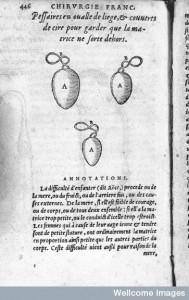 In the second of our occasional series on the kinds of therapeutic treatments that early modern medicine had to offer, we are going to look at the pessary.
In the second of our occasional series on the kinds of therapeutic treatments that early modern medicine had to offer, we are going to look at the pessary.
In 1583 Philip Barrough explained what a pessary was:
Pessarie is a medicine which is made of softe woll, or such like thing, and it is put into the privities of women. The figure or shape of it is like a suppositary, but that it is longer and thicker, because it must be put into the wombe. It is made of waxe, or of cloath or cotton, or of lint first dipped & wet in oyntment, or in a medicine meete and conuenient for the cure. Afterward wind them in silke, and hang a thread thereon, that it may be drawen out the more easilie.1
A pessary, then as now, was most often used as a means of delivering medication internally, and was placed into the vagina, not the uterus, but in fact Barrough’s use of the term ‘wombe’ did mean vagina rather than uterus. Elaine Hobby explains in the Introduction to Jane Sharp’s The Midwives Book that the term womb often meant the same in the seventeenth century as it does today, but is differentiated from its ‘neck’, the vagina, and ‘mouth’, the cervix. However, sometimes the womb is known as the ‘bottom’ and ‘womb’ means the vagina.2
Nearly a hundred years later Moses Charras’s explanation was similar:
Under the name of Pessaries, are comprehended all Medicines not liquid, which are put up into the Secret-parts of Women. But by the word Pessary, strictly tak’n, is to be understood a sort of solid Medicine, about a fingers length, sometimes somewhat bigger, which is put up into the Secret-parts with a Riband fasten’d to one end.3
He went on to explain the two therapeutic uses of a pessary which were to ‘provoke the menstruum’s, or to stop them [and] to hinder the falling down of the Matrix’. As Charras made clear, a pessary could be used to deliver medicines which could help a woman to deal with difficulties connected to her menstrual cycle. This was the primary use of the pessary. Gerard’s Herbal (London, 1633) lists a wide range of therapeutic herbs that could be delivered this way. These include ‘Sorcerer’s Garlicke’ (Allium moly) and Gum Succorie (Chondrilla juncea- a member of the daisy family) for bringing on a menstrual period, and by the same logic mandrake and briony were thought to help deliver a dead child and its afterbirth when used under a pessary, balme apple for healing an ulcer of the womb, and Jupiter’s beard or Iovis Barba which was said to be very good for stopping heavy menstrual periods.
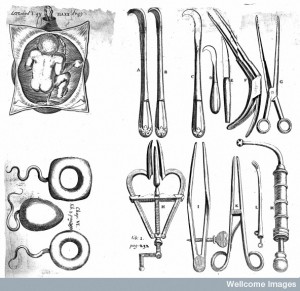
In her important 1981 article ‘Attitudes to Menstruation in Seventeenth-Century England’ Patricia Crawford commented that ‘there was no unwillingness to advise married women to insert objects into the vagina’.4 This too was a key point in the use of treatment by pessary. It was only thought suitable for married women. To treat a ‘maid’ this way was to compromise her virginity and risk her reputation and so the treatment was strictly limited to married women.
The second use for the pessary involved a different type of object. The first one looked like the middle the three pessaries pictured (above), and somewhat like a larger version of a modern tampon, whereas to hold in a prolapsed womb a pessary looking more like the bottom one was used. French surgeon Jacque Guillemeau described how best to treat this event – a common event in women who have had many deliveries – by firstly anointing the womb gently with a fresh butter mixed with rose oil. Then the midwife should gently manipulate the womb back into place. The pessary is then used to hold it in place.
For the second intention, which is to keepe the Matrice [uterus] in his place, when it is well put up and placed, the best and surest meanes is to thrust up a pessary, such a one as is here described, which hath this power to keepe the Matrice up, and yet not put it to any paine.5
Guillemeau advised keeping the pessary in place for a few days before replacing it with a fresh one
The Pessarie being put up, let it abide there two or three daies, when you take it out, put up a fresh one, keeping that to serve another time. There must also be a little string tyed to it, so to be fastned to a girdle, or some other thing, least it fall downe to the ground.6
Pessaries for this use were made out of several materials but often cork which was covered in wax to make it waterproof. William Sermon’s The Ladies Companion describes how to manufacture a pessary this way; Sermon and Guillemeau both stressed the importance of making sure that this ring had a hole in it so as not to hinder the ‘usual purgation’.7 This was considered vital: anything which caused either menstrual blood or lochia to be retained in the body was thought to be most dangerous to health. Guillemeau emphasises this when he added that you must not use any astringent medication on the pessary
If the woman be newly deliver’d, and in her sicknesse [i.e. bleeding]; you must not use any astringent medicine, for feare least you stay [stop] that; but it is sufficient to keep the pessarie there.8
The pessary then was a key and versatile tool in the treatment of ‘the diseases of women’ but one which was to used within defined limits.
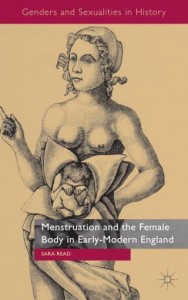 Dr Sara Read is a regular contributor to this blog. Her first monograph Menstruation and the Female Body will be published on the 4th September.
Dr Sara Read is a regular contributor to this blog. Her first monograph Menstruation and the Female Body will be published on the 4th September.
She is also, along with Rachel Adcock and Anna Warzycha, organising a conference ‘Early Modern Women, Religion, and the Body’ to be held on 22-23 July 2014 at Loughborough University. More information about Sara and her research can be found in the ‘About‘ section of this website.
1 The methode of phisicke conteyning the causes, signes, and cures of invvard diseases in mans body from the head to the foote (London, 1583), p. 279.
2 Elaine Hobby, ‘Introduction’, in The Midwives Book; or, The Whole Art of Midwifry Discovered (Oxford, 1999), pp. xi-xxxi (p. xxxi).
3 Moses Charras, The Royal Pharmacopoeea, Galenical and Chymical (London, 1678), p. 61.
4 ‘Attitudes to Menstruation in Seventeenth-Century England’, Past and Present, 91 (1981), 47-73 (p. 55).
5 Jacques Guillemeau, The Happie Delivery (London, 1612), p. 240.
6 Ibid., p. 241.
7 The Ladies Companion; or, The English Midwife (London, 1671), p. 150. The illustration here is taken from Franҫois Mauriceau, The Diseases of Women with Child, and in Child-bed (London, 1672), p. 306.
8 Guillemeau, The Happie Delivery, p. 242.
© Copyright Sara Read, all rights reserved.
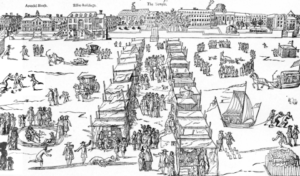



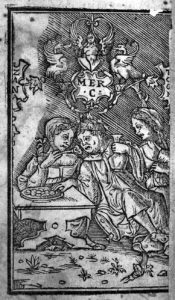
Well spotted. Your interests have helped you to identify a missing component to our understanding of early modern medicine. One might add the douche, the catheter, and the suppository.
I write under correction but I suspect that squeamishness or modesty might have influenced past generations of historians, as well as the focus on Big Ideas and Great Men. It’s also an area of practice that leaves relatively little in the way of detailed discussion. Modesty may be a social construct, and its focus changes over time, but it’s hardly novel.
If a physician or an apothecary-physician with a riding practice prescribed such treatment, who applied it? This is a question especially relevant to your recent work, but it would also arise with male patients. For me, of course, the role of the midwife outside the context of childbirth springs to mind, as well as the symbiotic relationships formed between midwives and male practitioners.
I agree, it is very interesting to think about who would have been involved in applying such treatments. In my own research I know that pessaries and douches were recommended to treat infertility as well. They were sometimes described alongside the use of fumigations and that was part of my wondering about whether physicians described these things as a range of potential treatments, allowing for different levels of social modesty. I also think you might be right in that this could be part of the midwife’s role. It also puts me in mind of the 17th century handbills that state that the doctor’s wife is also available for modest women to discuss feminine illnesses with.
For men there is a lot about the insertion of catheters in the suggested treatments but as you say far less on the actual use of such things. There are a few mentions in surgical observations. There is also discussion of inserting wax candles with linen wraps into the male genitals in order to discover carbuncles an ulcers. I imagine another consideration particularly with catheters might also be the discomfort or pain, not only is it perhaps an issue of modesty but combined with that it probably was not very pleasant.
I forgot to mention that it’s not just the older styles of medical history that have such lacunae. Such intimate practices, except in the case of of some historians of childbirth, tend to fall outside the interests and methods of social historians and, even more so, cultural historians. I may be mistaken, but I don’t recall even the admirable Laura Gowing talking about embodiment at such close quarters.
Like purgatives, these practices fall between three stools. Yet they, if we want to understand intimately the social and cultural entanglements of medicine and bodies, they are surely fundamental.
I agree I think we could gain a lot from thinking about the nitty gritty of some of these treatments. I’m sure Sara has thought about these things having started from the premise of women’s bleeding.
Bloodletting is another such gap, surely. How widespread was prophylactic phlebotomy? How religiously were the dog days observed? Where and when was wet cupping commonly employed?
Leeches may not have a social history, but their use surely does. Roberts Bartholow’s widely read book, A Practical Treatise on Materia Medica and Therapeutics, discussed leeches in the 19th century but where are the early modern leeches? Was there a trade in them, involving leechbreeders and leechmongers? Did they live in jars at the apothecary’s shop? Or were there few leeches in gainful employment?
I’m not sure how many historians would spot the problems involved in this sentence:
— ‘And in medieval Europe, leeches were so closely associated with doctors that physicians were called “leeches” — and they used millions of the parasites annually to treat patients. ‘
http://www.pbs.org/wnet/nature/bloodysuckers/leech.html
I have been wondering about leeches recently, not in a serious research way but just generally, I don’t see them very much in medical treatises, written by ‘physicians’ or ”surgeons. Were they supposedly used by irregulars, or barber-surgeons?
Three examples come to mind, one is an extended passage in a text I used for my essay on medical disputes, in The Medical Enlightenment of the Eighteenth Century, and the others from well-known books I happen to have. The Willis examples would need to be checked against the Latin original, if such a thing can be found. Pordage’s translation is a chocolate teapot.
Alius Medicus, Animadversions on the medicinal observations of the Heidelberg, Palatinate, Dorchester practitioner of physick, Mr. Frederick Loss (1674)
Culpeper, English Physician — If a Bean be parted in two, the skin being taken away, and laid on the place where a Leech hath been set that bleedeth too much, it staieth the bleeding.
Dr. Willis’s practice of physick — The day following the vomiting, unless any thing shall prohibit, let blood be taken out of the Arm, or from the Hemerhod Veins with a Leech: then the next day after, let a purging medicine be taken, which afterwards may be repeated constantly four days every new Moon
For that in little Children, obnoxious to this hereditary Disease, the Convulsive Fits are best prevented, if that an Issue be made presently after they are born in the nape of the Neck, and blood drawn with a from the Jugular Veins; for the corruptions of the Nervous Juice, are brought away by that, and the impure buddings of the blood, are diverted from the head by this: by these ways of administrations, when before two or three Children, of the same Parent, have died of Convulsions, soon after they were born, all the rest have been freed from the same evil.
…… the Infant for about four months was well, but then began to be troubled with Convulsions: at which time, the same remedies being administred both to the child, and to the nurse, in a larger dose, Vesicatores also were applied behind the ears, and blood was taken by the sucking of a Leech, from the jugular veins: within two or three days the child grew well: afterwards, whenever within four or five months the Convulsions returned, it was cured again, by the use of the same Remedies.
Thank you David! That is really useful. I just had a moment where I thought about how uncommon it was to see it mentioned in treatises and then got thinking about who was using it? Its interesting that Culpeper’s mention is not about using it but about after-care and also very interesting that Willis’s practice talks about children. Very interesting indeed. Thank you again
http://blogs.exeter.ac.uk/exeterblog/blog/2013/08/15/bloodletting-in-medicine-the-return-of-the-leech/
Thank you, Sara! You’ve just prompted me to have a look on EEBO for some further information about this. From what I’ve just read, though, and to pick up on a comment above, I’m not altogether sure that our categories work in relation to dividing up areas of investigation so rigidly (suppositories, pessaries, bloodletting): a quick EEBO search for the term “mother Suppositorie”, for example, demonstrates that these categories were not as fixed then as now. A great post to have given so much context and demonstrated the overlaps (even to the point of expelling menstrual blood) in such a short space!
Leeches are something that definitely needs some work doing on; thanks for the start David! And also so do maggots for that matter, which are back in favour in the NHS- and proving to be extremely effective, I believe. Whenever I see catheters mentioned, I am always struck by how timeless (in the treatment of women at least) their use is. For example, the use of catheters by midwives to relieve a full bladder that was slowing down a labour would be recommended in exactly the same way now. The difference I suppose is that they used a reed and we use a plastic tube.
I did originally consider including suppositories in this article, but it became clear early on that they warranted a whole post to themselves too!
We touched on cupping in an earlier blog post here a few weeks ago, but it really was just an overview.
Hopefully these sorts of posts on therapeutics will help the lay reader to contextualise some of the strange cures they see mention in other posts.
I touch on bloodletting in my forthcoming book, because there is some controversy about whether it was an appropriate treatment for a pregnant woman. In the course of this research, I found a quotation about how women often wouldn’t put up with being bled as much and as often as the doctor would like them to be, and found this particularly interesting as it suggests women actively engaging with and negotiating their treatments.
Thanks for your comments Claire – I usually end up with menstrual blood in there somewhere, even when I don’t intend to 🙂
Sara
“it suggests women actively engaging with and negotiating their treatments. ”
You thought they didn’t? Look at diaries, letters, and both the printed and manuscript recipe books. Men and women were passing around advice and “proved” remedies all the time.
Women had their “hierarchies of resort,” so they might have experience with the explanations and prescriptions of a wide range of practitioners. Families and friends had opinions, and expressed them. Self-medication was commonplace, as was kitchen physick.
Doctors were forever complaining about this, especially but not only in the case of women. If they failed to satisfy not only the patient but also any friends present, they could easily find their practice declining. We are well aware of this as a problem for men-midwives, but it was true for all kinds of practitioner. The rhetoric of explanation was at least as important as therapeutic efficacy.
Women were agents in their own healthcare, not passive patients. We are too apt to assume that the world of women has changed altogether from the 1960s onwards.
I don’t think either of us ever thought they didn’t but it might not be as obvious to a non-academic audience who perhaps think about this as a misogynistic patriarchal culture.
I think it was a point worth making , as like Jennifer said, it’s not that we ever thought they didn’t but reading through some of the prescriptive medical texts where doctors are pontificating on what it is best to do, you could pick up an idea that women’s views were irrelevant to physicians.
The notion that women in general, and midwives in particular, were passive victims is still widespread in the secondary literature. The further the work is from the archives, the more likely this view is to be present, but it can be seen even in surveys by professionals. It colours work on a wide range of topics.
Anatomy is an especially obvious example. One wouldn’t know from many studies just how small a proportion of most anatomical texts and their illustrations was devoted to the “secret parts of women”. The fact that many who write on such matters are incapable of reading the words of the texts doesn’t help.
Restoring the agency of women was a consistent theme among the early members of the Society for the Social History of Medicine, especially when it was led by Charles Webster. Contributions by such scholars as Jean Donnison and Trish Crawford were notable. I recently read through the early issues of the Bulletin of the Society for the Social History of Medicine and was struck by this development of the later 1970s.
Many of the issues now prominent in the field were raised in that journal’s debate about “Ignorant Midwives,” from 1981 onwards. Others, such as Adrian Wilson’s eminently sensible caution about the misleading potential of record linkage, have been neglected. Agency, symmetry, and false universals were among the topics touched upon. I wished I had re-read the contributions during the intervening years.
Unfortunately perhaps, the then editor, Margaret Pelling, felt that it was debate for its own sake and consequently rejected further contributions. She was not entirely wrong, but a discussion of theory and methods in the history of women’s health, involving a range of viewpoints, might well have proved useful.
The time for it had not yet come, and Social History of Medicine was not to have a format suited to concise contributions. As I recall, that was one of the reasons offered by Roy Porter in opposing the creation of the new journal, during the SSHM meeting at the IHR. His view was overwhelmed by the general enthusiasm for the more public identity that a journal might give.
There is still much great work being done on women and their relationships to medicine. Wendy Churchill’s new book is very interesting and follows on from works like Lianne McTavish and Cathy McClive, and may others. It thankfully doesn’t appear that widely accepted any more that midwives were ignorant.
As for “ignorant midwives” and “midwife-witches”, although the new orthodoxy has yet to be accepted, understood or even noticed everywhere or by everyone, I have long thought it was time to undermine or qualify it. Doreen Evenden’s much praised and widely cited book brought this home to me, it being the apogee of the “respectable midwife” stereotype.
I intend to criticize the belief that midwives were generally respectable and competent — the not-witches and not-ignorant stereotype that has developed among Anglophones. Sam Thomas has applied the respectability view tellingly for York, in essays and now in splendid novels, but I think we need to work against the hardening of a new orthodoxy.
I am working on writing one or more synthetic pieces, looking at areas of overlap and where both neglected archival resources, scattered across Europe, and the history of other regions that “modernized” later, such as provincial Russia, India and South-East Asia, can shed new light on developments in early modern Europe.
Moreover, Mary Fissell has opened up the relationship between childbirth and religion in new ways, as have several medievalists. Laura Gowing has also showed new ways to get below the surface of the standard early modern archives.
However, the reliance on the minority of archival documents written in English has severely limited the study of early modern England, in this as in so many other areas of social and cultural history. For example, there is much to be found that qualifies the work of Monica Green and revises standard views concerning the social structure of childbirth before midwife licensing.
I’ve made a start on some microhistorical work set in southern England before 1650, in the hope of using a wider array of evidence, but the 15th and 16th centuries are wide open, and I feel sure that the use of Latin court records, both secular and ecclesiastical where they survive, would enrich our understanding of the 17th and early 18th centuries.
“an appropriate treatment for a pregnant woman”
Historians have wondered if all the cautions against bleeding from the feet during pregnancy were covert advice on inducing abortions. I think not. Even Wesley gives this caution, as I recall. Standard method for “bringing on the flowers,” as you know, and there was plenty of knowledge about abortion.
Wading through the dismal depositions in infanticide cases, my impression was that the overwhelming majority concerned young servants who were far from the friends and family who could have helped them. Equally, I suspect that those who could be helped would rarely come to the attention of the courts in England. [German cases seem rather different.] Few English cases seem to involve mothers and apothecaries, although young men sometimes slipped the woman some sugar soaked with arsenic, which comes to the attention of doctors and magistrates if the dose was too strong.
That’s the key think about bloodletting in pregnancy. Concern that it could bring on a miscarriage was a very real one, which is why bleeding from the ankle was frowned on. But equally some doctors thought bleeding (from the arm) could avert a threatened miscarriage. This is why it was a difficult one for the woman to call. Alice Thornton recorded being caught between two doctors. One thought she should be bled, one that she shouldn’t. She,however, did want to be bled and got her way.
Sara,
love this post! To what extent do you think the use of pessaries are related to corsets and stays? I.e. in eras when tighter lacing occurs (which I believe was thought to increase the risk of prolapsed wombs), is there more of a need for pessaries? BTW, on a semi related issue, colonial American scholars often repeat one early scholars’ claim that early modern women in the colonies “bled into their skirts” during their menstrual cycles, mainly because we lack information about what they did. Thoughts? Can’t wait to read your book!!
Hi Laura,
Thanks for your comments, which are extremely timely as I am looking at the corset at the moment in relation to my work on obesity (corsets as a diet aid and to make you look thinner). I think prolapse would have been incredibly common because of the number of births the average woman had (5-7), and then tight corsets are documented to have caused this and other ailments, but I think from what I’ve read that this is more common in the eighteenth century as the smaller waist becomes more desirable.
Would you be able to point me in the direction of some of the texts you mention which say that women bled into their clothes in colonial times? I think they probably did too, but this is based on evidence such as that one physician mentions that some women were forced to use cloths if they bled heavily, for example. The web-site mum.org has some interesting stuff on the history of sanitary protection too.
Best
Sara